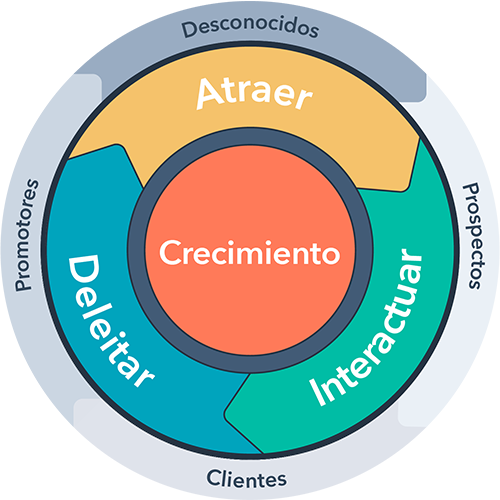Understanding Inbound Marketing
Inbound marketing revolves around crafting enriching experiences that leave a positive impact on individuals and your business.
But how can you achieve this?
Attract potential leads and customers to your website with valuable and relevant content. Once they arrive on your site, engage with them using conversational tools such as email and chat, ensuring lasting value. Show them your expertise and dedication by positioning yourself as a trusted advisor who truly understands their needs and is committed to their success.
Inbound marketing differs from traditional methods by effortlessly capturing the attention of potential customers. By creating tailored content that addresses the challenges and desires of your target audience, you will naturally attract qualified leads and build trust and credibility for your company.

What is Inbound?
The concept of inbound marketing revolves around attracting, engaging, and delighting potential customers to drive business growth through building value and trust. With the advancements in technology, this approach establishes a more effective and customer-centric way of conducting business. It provides a superior strategy for marketing, selling, and supporting customers, ultimately benefiting both the customer and the company, leading to sustained business growth.
The inbound methodology consists of three essential stages: attract, engage, and delight. Companies utilize this approach to build trust, credibility, and drive action. It's all about delivering value throughout the customer's journey.
Looking at it from a business standpoint, this methodology reflects your company's evolution, with happy customers driving its growth. They either continue to buy your products or recommend your business to others, expanding your brand reach. Conversely, dissatisfied customers, whether from a lack of alignment with your brand or unmet expectations, can impede your company's growth path.
By implementing an inbound strategy across all departments, your company can create a seamless and all-encompassing experience for every user, regardless of their stage as buyers. Attracting visitors to your website isn't just the responsibility of marketers; engaging with them shouldn't be confined to the sales team; and delighting them extends beyond the customer service department. To nurture lasting relationships with customers, all teams need to actively engage, interact, and delight them in a personalized manner, building trust in your brand.

What is flywheel?
The concept of the customer-driven flywheel serves as a powerful visual representation of how prioritizing exceptional customer experiences can propel an organization forward with unstoppable momentum. Implementing strategies to attract and retain customers infuses the flywheel with energy, keeping it spinning smoothly. However, factors that hinder this momentum, known as friction, often arise during team interactions, such as when leads transition between departments. This underscores the critical role of internal communication in maintaining the cycle's rotation.
When your Flywheel is aligned with the inbound methodology, your marketing, sales, and customer service teams play key roles in driving momentum and overcoming challenges at every stage of the process. It is crucial for all departments in the organization to be fully committed to this shared goal.
For example, the marketing team's focus in the attraction phase involves activities such as monitoring blogs, hosting events, and running paid advertising campaigns. The sales team propels the cycle forward through interactions on social media platforms, while the customer service department encourages satisfied customers to advocate for your brand.
As you move through the phases of attracting, engaging, and delighting customers, it is their advocacy that will sustain the momentum of the cycle, attracting new customers. Over time, the Flywheel model will allow your business to grow without constantly relying on customer acquisition efforts.
The use of Inbound Marketing methodology
Our objective with inbound marketing is to attract new leads, engage with them effectively, and provide personalized satisfaction. It is also vital to collaborate with the sales and customer service teams to maintain smooth operations and drive continuous company growth. Despite the challenging nature of this task, the inbound methodology and marketing automation tools provide the necessary foundation for achieving success.

Attraction Tools
- Content strategy
- Blog posts
- Social media distribution
- Video
- Ads
Interaction Tools
- Value content
- Conversion streams
- Email marketing
- Conversational bots
- Lead management
Delight Tools
- Intelligent content
- Inbox
- Email marketing
- Attribution reporting
- Marketing automation
Attract
The main focus should be on attracting the right users to your website, those who are more likely to convert into valuable sales opportunities and satisfied customers. How can you achieve this? By delivering relevant content to your target audience when they are actively seeking that information.
Utilize the Content Strategy tool to establish a solid online presence in search results and rank well for the key topics that are important to your potential customers. Share compelling blog posts or video content on your social media platforms using the available tools. Create ads to increase brand visibility within your target demographic. It is crucial to analyze and evaluate these efforts at each stage to identify successful strategies and areas for improvement.
Interact
Discover how the Conversations tool can help you build strong connections with potential customers through various communication channels like email, bots, live chat, messaging apps, and more. Utilize conversion tools such as CTAs, forms, and lead flows to collect valuable data from website visitors.
Make the most of prospect and customer information stored in the CRM system to personalize the website experience with tailored content throughout the buyer's journey. Cultivate brand loyalty by targeting specific audiences with customized ads or social media content. Explore a variety of plug-in integrations to enhance your toolkit and meet your business's unique needs.
Delight
Utilize Conversations, Email, and Marketing Automation tools to consistently deliver personalized information to the right audience at the right time.
Employ Conversations Inbox to align your sales and customer service teams, allowing them to participate in meaningful conversations with your customers. Develop engaging content that connects with potential clients, motivating them to share it with their social networks in various formats such as videos.

